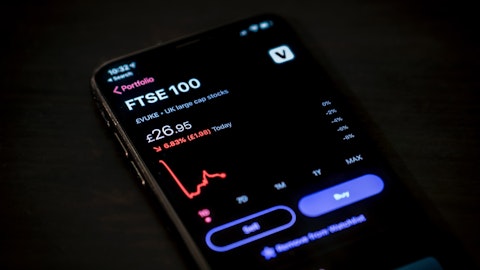Brian Robbins: Yes. Let me answer the first — or the last and I’ll move to the first. And so as I noted, this was our highest first order quarter in company history. And so as the platform trend is picking up, and people are looking to consolidate, that’s part of the reason why we had so many new logos from a first order perspective this quarter. And your first question was enterprise, mid-market and SMB and sort of what we’re seeing there. In U.S. versus rest of the world, our pipeline remains healthy all over the world. And so, there’s not a particular region like Europe, in particular, that we’re saying, “Hey, we’re seeing some issues in Europe.” It remains healthy all over the world because we have such a long tail of customers, and there’s really — there’s not a few customers that are heavily weighted towards making up a large percent of our revenue, they’re all acting relatively about the same.
We have very little exposure to the tech. If you look at or startups, overall, we’re about 20% exposure tech, but if you look at start-ups, we’re less than 5%, and that’s companies less than 200 employees in the tech field. And so the fact that we have one platform, whether it’s Self-Managed or SaaS, we do zero customization to it and this push to go to the cloud and to reduced costs is helping us. Some of the things that we are seeing is, as I mentioned, some of the watch points is we’re seeing a slight uptick in contraction. And so maybe some of those companies who did a layoff where we were more fully penetrated, they’ve cut back in a couple of licenses. And we have seen some of the deals require greater scrutiny. And so where this is typically done at sort of a division department basis, we may require CFO approval or some C-level approval to acquire new software.
Sharlene Seemungal: We’ll now move on to Jason from William Blair.
Jason Ader: Yes, when you go through — and you talked a little bit about this, Brian, but can you go through the puts and takes on NRR relative to seat expansion and upsell. Where do you see the strength currently? It sounds like maybe some contraction on seats may affect — may have affected you this quarter? And then you also talked about upsell maybe being under a little bit of pressure. But yet your NRR was sort of — sounds like it was similar. So how is it manifesting? And what are some of the puts and takes here? Help us reconcile all this?
Brian Robbins: Yes, absolutely. Thanks, Jason. We haven’t seen too much change in our net dollar retention rate overall. Seat expansion remains the biggest driver. As I mentioned, the cohort seven years ago that’s still expanding at the same rate as a cohort two years ago. Seat expansion is the biggest driver there as well. The second biggest is tier upgrades. We mentioned Ultimate is still 39% of ARR, but growing in excess of 100%. And so we had a — like I said, we had a really great first order quarter and so that did well. The expansion, as I mentioned, some deals are getting greater scrutiny. So this quarter, we saw a little bit more scrutiny on expansion. But I would say the — there hasn’t been too much dramatic changes in the net dollar retention rate. It’s been fairly consistent for the last several quarters.
Jason Ader: Okay. So maybe just a slight downtick. Is that the right way to think about it?
Brian Robbins: Correct.
Sharlene Seemungal: Our next question comes from Koji from Bank of America.
Koji Ikeda: Thanks for taking my question. Maybe one for Sid. I wanted to go back to the GitLab Govern product that you’re talking about. You mentioned vulnerability management. Also in the press release, you mentioned the supply chain of software. So just curious, this vulnerability management at what level or depth does it go? Does it go to the binary level, the source code level? And the vulnerability management or maybe the visibility, does it go across all applications that may be using similar blocks of source code or binaries? Any sort of help there would be helpful.
Sid Sijbrandij: Yes, for sure. Thanks for the question. So GitLab Govern vulnerability management, it goes as deep as you expect. So we do, for example, container space scanning, which are typically binaries. Additionally, in GitLab Govern is also audit events, compliance management. We’re working on security policy management, which is in the product, but still has some maturing to do. And what it helps companies do is to prove their auditing but also to do it every single time. So we see a lot of companies. They bought multiple point solutions for security and use it for some of their applications, some of the time. And what GitLab really helps them do is do it for every application, all of the time and prove that to the auditors. So that’s a big benefit. And the ways to do there is to be able to provide the visibility to be able to enforce it, but also to make it frictionless for the developers and the security people.





